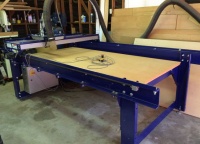Difference between revisions of "Shopbot"
Brad Cozine (talk | contribs) m |
Brad Cozine (talk | contribs) m (→Tasks) |
||
| Line 21: | Line 21: | ||
*{{todo|what=Move power switch to a more accessible location.}} | *{{todo|what=Move power switch to a more accessible location.}} | ||
*{{todo|what=Dust coolection.}} | *{{todo|what=Dust coolection.}} | ||
| + | *{{todo|what=Touch plate support.}} | ||
==Contacts== | ==Contacts== | ||
Latest revision as of 10:32, 1 November 2023
Contents
The shopbot is a wood CNC router in the woodshop. We have been teaching introductory classes to the Shopbot and CNC on roughly a monthly basis. Look at the calendar for classes. These are limited in size, and we split into 2 groups to get hands on, each covering the shopbot and one of the two software packages that's being used.
Note, that like everything in the woodshop, use of the Shopbot requires that you be authorized to use the woodshop, via the class.
Software
There are several ways to generate the g-code required for LinuxCNC to use the shopbot.
For very simple applications: http://easel.inventables.com/
For more advanced: http://www.autodesk.com/products/fusion-360/overview
Problems
One problem that has been encountered is that due to trying to keep the feed rate up, the motion planner will cut some corners. To prevent this add the line to your program: "G64 P0.001". This will tell it to keep deviations to less than 0.001 units (mm or in), while still attempting to keep the speed up as much as possible. You can use a higher value if you want to. See here for a more complete discussion as to why that happens: http://linuxcnc.org/docs/2.6/html/common/User_Concepts.html
Tasks
- @TODO (unassigned, no date): "G64 P0.001" should not be required to be manually added. The issue can be fixed in configuration.
- @TODO (unassigned, no date): Move power switch to a more accessible location.
- @TODO (unassigned, no date): Dust coolection.
- @TODO (unassigned, no date): Touch plate support.
